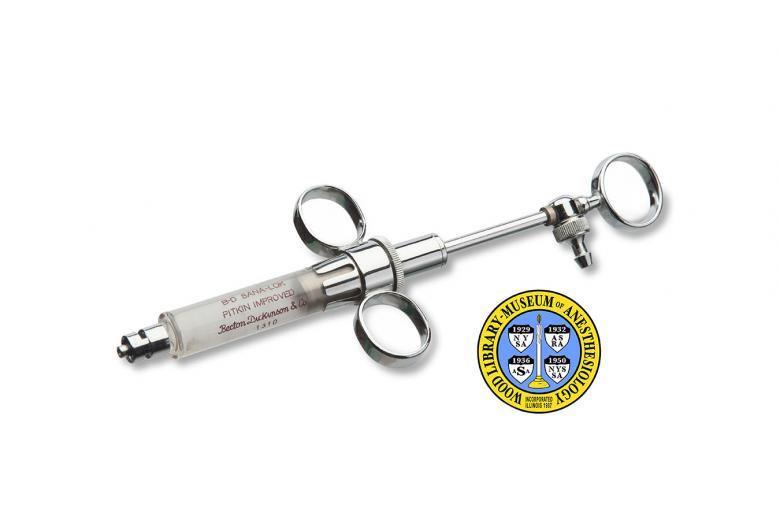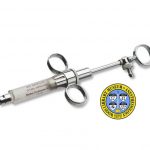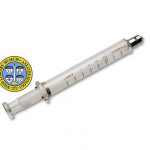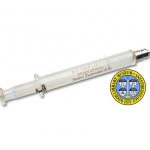Pitkin Syringe
Spinal anesthesia involves the injection of local anesthetics around the spine to quickly block pain in large regions of the body. The American surgeon, Dr. George P. Pitkin (1885-1943) was born in the year that spinal anesthesia was first introduced. But the procedure brought difficulties as well as benefits, and by the 1920s most American surgeons had rejected it. Dr. Pitkin described his own technique for "controllable" spinal anesthesia in 1927, and became a strong advocate for safe spinal anesthesia. He noted that some complications of inhalation anesthesia could be avoided by using regional anesthesia instead, and that some of the complications of spinal anesthesia could be avoided by careful control over the patient's position on the operating table. He wrote: "I would say that inhalation anesthesia in general will be in a class with chloroform 10 years hence and spinal or regional will be the anesthesia of choice."
In the same paper, Dr. Pitkin described his local anesthesia syringe and 22 gauge needle, as well as a new anesthetic formula later called Spinocain. The syringe could be refilled through a tube without disconnecting the syringe or reinserting the needle multiple times. This was a step toward continuous spinal anesthesia, a technique that was introduced by Dr. William Lemmon in 1940. Here are two forms of the Pitkin syringe.
Catalog Record: Pitkin Syringe
Catalog records for the B-D sana-lok Pitkin improved syringe (akil) and the B-D Yale Luer-lok Pitkin spinal syringe (akim):
Access Key: akil
Accession No.: 1999-09-18-1
Title: B-D sana-lok Pitkin improved [syringe / designed by George P. Pitkin].
Author: Pitkin, George Philo, 1885-1943.
Title variation: Alt Title
Title: Improved Pitkin syringe.
Publisher: [New Jersey] : Becton Dickinson & Co, [1960-1980].
Physical Descript: 1 syringe : metal, glass ; 7.5 x 2.5 x 21 cm.
Subject: Syringes – instrumentation.
Subject: Anesthesia, Regional – instrumentation.
Subject: Anesthesia, Conduction – instrumentation.
Subject: Anesthesia, Obstetrical – history.
Subject: Pitkin, George Philo, 1885-1943.
Note Type: General
Notes: Broad date range (1960-1990) for possible year of manufacture based on the
word “improved” on the syringe and on dates of publications mentioning the
syringe. The date range could change if documentation indicates the range
should be corrected.
Note Type: Citation
Notes: American Hospital Supply Corporation, American V. Mueller Division. SANA-LOK
PITKIN Syringe. The Surgical Armamentarium: Instruments, Professional
Equipment. Chicago: Rand, McNally; 1973:352.
Note Type: Citation
Notes: Maxson LH. Introduction. Spinal Anesthesia. Philadelphia: JB Lippincott;
1938:ix-x.
Note Type: Citation
Notes: Pitkin GP. Controllable spinal anesthesia. Am J Surg. 1928;5(6):537-553.
Note Type: Citation
Notes: Pitkin GP. Controllable spinal anesthesia with spinocaine. Anesth Analg.
1929;8(2):78-90.
Note Type: Citation
Notes: Pitkin GP, inventor. Local-anaesthetic syringe. US patent 1,681,744. August
21, 1928.
Note Type: Citation
Notes: Rosenberg H, Axelrod JK. Two surgeons who popularized spinal anesthesia. Reg
Anesth Pain Med. 2001;26(3):278-282.
Note Type: Citation
Notes: Southworth JL. [Dedication]. Conduction Anesthesia. Philadelphia: JB
Lippincot Co.; 1953:vi.
Note Type: Physical Description
Notes: One syringe for the administration of local anesthetics; It has a glass
barrel and metal needle hub and pulger; It also has metal finger holds; The
glass barrel is marked with dark red lettering: The markings include, “B-D
SANA-LOK [new line] PITKIN IMPROVED [new line] Becton Dickinson & Co [new
line] 1310”; The barrel is gratuated with .2 cc marks up to 5 ccs; the 1, 2,
3, 4, and 5 marks are numbered; The needle hub is marked with, “”B-D LUER-LOK
PAT. 1742497”; The plunger is springloaded so that it automatically returns
to the 5 cc position when releasted; Just below the thumbhold on the plunger
is a port which contains a valve; The port can be connected to tubing for the
refill of the plunger.
Note Type: Reproduction
Notes: Photographed by Mr. Steve Donisch on January 16, 2013.
Note Type: Historical
Notes: Surgeon George P. Pitkin (1885-1943) is credited with reigniting widespread
interest in spinal anesthesia at a time when the majority of American
surgeons wanted nothing to do with it. Spinal anesthesia involves the
injection of local anesthetics around the spine to quickly block pain in
large regions of the body. Around 1927, with rare drive, Dr. Pitkin began to
advocate for the safe use of spinal anesthesia. To address specific
difficulties previously encountered with the procedure, he developed specific
techniques for others to follow, calling the overall method, “Controllable
Spinal Anesthesia.” Some referred to it as the “Pitkin Technique.” In many of
his early publications on the subject Dr. Pitkin called attention to
significant contributions made by colleagues in the development of his
methods.
Note Type: Historical
Notes: The syringe designed by Dr. Pitkin allowed for the administration of more
local anesthetic than the syringe alone would hold. The side port on the
plunger could be attached to a tube that ran to a container of liquid local
anesthetic. When all of the anesthetic in the syringe had been used, the
physician would release the spring loaded plunger, and the syringe would
automatically refill while the plunger returned to the full position. The
doctor could administer the required dose using a manageably sized syringe
without disconnecting the syringe from the needle or reinserting the needle
multiple times. The “Pitkin Improved” Syringe described here has a capacity
of 5 cc (cubic centimeter).
Note Type: Historical
Notes: Other components of Dr. Pitkin’s spinal anesthesia technique included a very
fine needle, a specific formula of anesthesic called “Spinocain”, and a
device, called a “Tiltometer,” used to carefully control the position of the
patient.
Note Type: Publication
Notes: Gosse NH. Spinocaine in spinal anaesthesia. Can Med Assoc J. 1929;20(1):29-31
Note Type: Publication
Notes: Pitkin GP. Controllable spinal anesthesia. J Med Soc New Jersey. July,
1927;24:425-438.
Note Type: Publication
Notes: Pitkin GP. Spinal anesthesia. JAMA. 1928;91(11):819-820.
Note Type: Publication
Notes: Pitkin GP. Spinal anesthesia in obstetrics and gynecology. Am J Obstet
Gynecol. 1929;18:165-171.
Note Type: Publication
Notes: Pitkin GP, McCormack FC. Controllable spinal anesthesia in obstetrics. Surg
Gynecol Obstet. 1928;47:713-726.
Note Type: Exhibition
Notes: Chosen for the WLM website (noted July 30, 2013); Exhibited on the same
webpage as a B-D Yale Luer-lok Pitkin spinal.
Access Key: akim
Accession No.: 1993-11-23-1 A
Title: B-D Yale Luer-lok Pitkin spinal.
Author: Pitkin, George Philo, 1885-1943.
Corporate Author: Becton, Dickinson and Company.
Title: Pitkin spinal [syringe].
Publisher: [New Jersey] : Becton Dickinson & Co., [1930-1940].
Physical Descript: 1 syringe : glass, metal : 2 x 2.5 x 13 cm.
Subject: Syringes – instrumentation.
Subject: Anesthesia, Regional – instrumentation.
Subject: Anesthesia, Conduction – instrumentation.
Subject: Anesthesia, Spinal – history.
Note Type: General
Notes: Generous date range for possible year of manufacture based on information
provided by the donor.
Note Type: With
Notes: Donated inside a red cardboard box measuring approximately 3 x 8.5 x 16.5 cm.
; Written in red ink on the top of the box is, “Contains special syringe for
spinal anesthesia given me by Winthrop Chemical in 1940 at request of Dr.
George Pitkin” and “L.J. Hampton, M.D.”
Note Type: Citation
Notes: Carson JS, Harkness TT, Hampton LJ, Chase HR. Clinical experiences with
fluothane: a new nonexplosive anesthetic. Ann Surg. 1959;149(1):100-106.
Note Type: Citation
Notes: Cathcart RT, Nealon TF Jr, Fraimow W, Hampton LJ, Gibbon JH Jr. Cardiac
output under general anesthesia; effect of mean endotracheal pressure. Ann
Surg. 1958;148(3):488-497.
Note Type: Citation
Notes: Hampton LJ, Little DM. Results of a questionaire concerning controlled
hypotention in anaesthesia. Lancet. 1953;1(6774):1299-1300.
Note Type: Citation
Notes: Little DM Jr, Hampton LJ, Grosskreutz DC. Succinylcholine (diacetylcholine):
a controllable muscle relaxant. Curr Res Anesth Analg. 1953;32(3):171-180.
Note Type: Citation
Notes: Pitkin GP. A nonoxidizing epinephrine to prolong spinal anesthesia with a
subarachnoid capacity control. Anesth Analg. 1940;19(5):241-260.
Note Type: Citation
Notes: Pitkin GP. A nonoxidizing epinephrine to prolong spinal anesthesia with a
subarachnoid capacity control (concluded). Anesth Analg. 1940;19(6):315-329.
Note Type: Citation
Notes: Rosenberg H, Axelrod JK. Two surgeons who popularized spinal anesthesia. Reg
Anesth Pain Med. 2001;26(3):278-282.
Note Type: Physical Description
Notes: One glass syringe with a metal needle hub and a small metal piece at the end
of the barrel which asts to keep they plunger from slipping too easily out of
the barrel; The barrel and the plunger are both glass; Eight graduation marks
are numbered differently on each side; On one side they are numbered in cc’s
from 1 to 8, 1 starting nearest the needle hub; Mared along the other side of
the gradution, reading from left to right (from the end near the plunger to
the end near the needle hub), is, “LUMBAR”, 1, 2, 3, 4, and “INTERSPACE”; The
1, 2, 3, and 4 on this side correspond to the 6, 5, 4, and 3 on the other
side, respectively; Also marked on the barrel of the syringe in dark red ink
is, “B-D YALE LUER-LOK [new line] PITKIN SPINAL [new line] Becton Dickinson &
Co”; Also marked on the syringe is, 11Y”.
Note Type: Reproduction
Notes: Photographed by Mr. Steve Donisch on January 16, 2013.
Note Type: Acquisition
Notes: Donated to the WLM by Louis Jennings Hampton, MD.
Note Type: Historical
Notes: This syringe for spinal anesthesia was donated to the Wood Library by
anesthesiologist L. Jennings Hampton (1906-1994). In 1939, Dr. Hampton
planned a visit with surgeon and spinal anesthesia specialist Dr. George P.
Pitkin (1885-1943). Hampton wanted to observe Pitkin and better learn
particular techniques for spinal anesthesia. A few months later, at the
request of Dr. Pitkin, Winthrop Chemical Company shipped to Dr. Hampton a
newly formulated local anesthetic for spinal anesthesia. Called “S. A. 406”,
it had been developed with Dr. Pitkin and was still in the testing phase.
Winthrop also sent Dr. Hampton this complementary syringe made by Becton,
Dickinson and Company.
Note Type: Historical
Notes: In their correspondence, Dr. Pitkin suggested that he and Dr. Hampton
collaborate on research and write an article on the new anesthetic.
Unfortunately Pitkin died unexpectedly in 1943. The investigation of S. A.
406 was not the only thing left unfinished. For two years he had been
carefully planning and writing a detailed and practical book on local and
regional anesthesia. After his death, Dr. Pitkin’s friends, colleagues, and
wife, Winifred Mercer Pitkin, MD, a neuroanatomist, banded together to finish
the text in his honor. One of the editors dedicated to this effort was the
accomplished anesthesiologist Robert A Hingson (1913 – 1996).
Note Type: Historical
Notes: Dr. L. Jennings Hampton practiced and taught at a number of institutions
during his career. While with Yale University School of Medicine and then
Jefferson Medical College he published on a number of topics particularly
salient to anesthesiologists, including his studies on muscle relaxants,
controlled hypotension, the then-new inhalation anesthetic halothane, and the
effect of general anesthesia on heart function.
Note Type: Publication
Notes: Gosse NH. Spinocaine in spinal anaesthesia. Can Med Assoc J. 1929;20(1):29-31
Note Type: Exhibition
Notes: Chosen for the WLM website (noted July 30, 2013); Exhibited on the same
webpage as a Pitkin Improved syringe.




